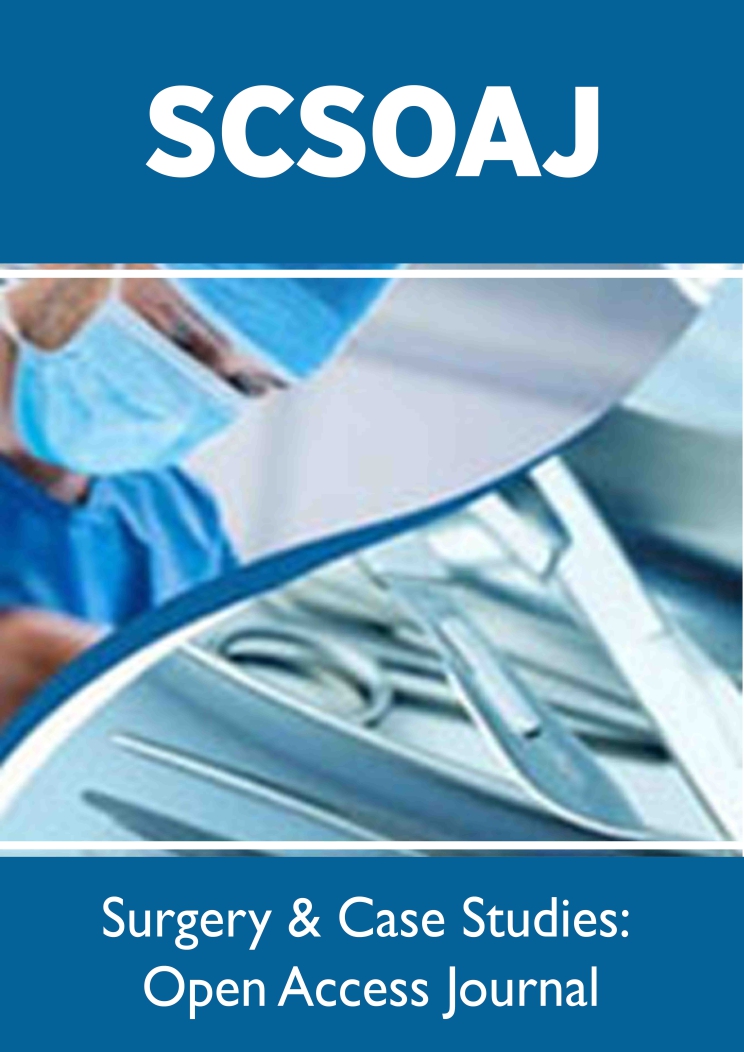
Lupine Publishers Group
Lupine Publishers
Menu
ISSN: 2643-6760
Mini Review(ISSN: 2643-6760) 
Gossypiboma: Factors Leading, Preventive Measures, and Medico-legal Issues Volume 7 - Issue 4
Mohammad ali almokdad1, Mansour el Khoury2*
- 1Rosary sisters Hospital University Medical Center
- 2Balamand university
Received: November 01, 2023; Published: December 13, 2023
Corresponding author: Mansour el Khoury, associate professor of clinical surgery, Balamand university, Lebanon
DOI: 10.32474/SCSOAJ.2023.07.000270
Introduction
Despite preventive measures taken before, during and after an open surgery, sponges and surgical instruments are still accidentally left inside patients [1]. Gossypiboma or textiloma are terms used for cotton or woven fabric left inadvertently in the body cavity of patients after surgical interventions [2]. The first case of gossypiboma was reported by Wilson 1884 [1]. Gossybiboma is rare, yet it is a common and persistent serious medical error that can cause definitive harm to patients, hospitals, and surgeons [3]. Although an actual incident has not been determined due to medico-legal issues, asymptomatic nature for long time (varying from days to years after the surgery) and under-reporting of cases [4], estimates suggest that such an error occur in 1/100 to 1/3000 of all surgical interventions, and in about 1/1000 to 1/1500 of intra-abdominal operations [5]. Gossypiboma may occur as a complication following different types of surgical procedures such as intrathoracic surgery, cardiovascular surgery, orthopedic surgery, and neurosurgery as well as breast surgery, but the most common type is intra-abdominal surgery. The condition is more common in developing countries and has a higher incidence in females compared to males [4,6]. The diagnosis of gossypiboma is difficult as it is clinical presentation is associated with general symptoms like fever, rectal bleeding, pain, nausea, vomiting, diarrhoea, and weight loss [1].
Discussion
The word “gossypiboma” originates from the Latin word “Gossypium” meaning cotton and the Swahili word “boma” meaning place of concealment. The term “textiloma” originates from the Latin word “textile” meaning weave in and the Greek word “oma” meaning swelling [2,7]. Gossypiboma can cause potential harm affecting the morbidity and mortality of patients. From a pathophysiological aspect, gossypiboma evokes two types of foreign body reactions. A potential reaction that usually occurs early during the postoperative course, is the exudative reaction. This reaction typically occurs when the human body attempt to expel the foreign body into an external opening or force it into a viscus hollow, leading to fistula or abscess formation. Moreover, a fibrous aseptic reaction may occur creating adhesions and encapsulation that mimic the symptoms of an occlusion or pseudotumor. Rarely, the foreign body can be excreted spontaneously through the anus driven by the peristaltic movement of the intestine [1,6].
Radiography plays a crucial rule in detecting gossypiboma. However, it is difficult to detect retained sponges post-operatively using radiological imaging, unless they have radiopaque markers. Nevertheless, the diagnosis of gossypiboma is complicated and induces a high suspicious index because these markers may be distorted by twisting, folding, or disintegration over time. The appearance of gossypiboma on radiological imaging varies, it may be misdiagnosed as an abscess, haematoma, or neoplastic lesions [2,5]. On ultrasound, a prominent finding of gossypiboma may show an echogenic area with a strong posterior acoustic shadow as a consequence of the multiple fluid-cotton interfaces. The nature of the mass (solid or liquid) and its volume (in case of pseudotumor syndrome) are showed on ultrasound. Moreover, the images on ultrasound may be classified as cystic or solid. The cystic lesions are presented by a zigzag echogenic bundle, while the solid lesions are described as a complex mass having a mixture of hypo and hyperechoic pattern [1,2,5,8]. On the other hand, computed tomography (CT) is the choice in detecting gossypiboma and its associated complications. Typically, the most common feature demonstrated by gossypiboma on CT, is a spongiform pattern with entrapped gas bubbles. The presence of wavy stripped, high-density area represents the sponge itself. Calcifications and gas bubble may be present in longer standing gossypiboma [1,2,5]. Magnetic resonance imaging features of gossypiboma are described as hypointense images on T1 and hyperintense images on T2 as well as a well-circumscribed, capsulated mass on T2 weighted image [1,6]. Significantly, gossipyboma is associated with various risk factors. The three most highlighted risk factors are emergent procedures, unexpected adjustments in operative strategy, and overweight patients (body mass index (BMI) > 28) [9]. Gawande et.al, found that retention of foreign bodies is nine times more likely to happen when an operation is performed on emergency basis, and four times more likely when there is unplanned change in operative strategy. In addition to that, they suggested that the increased risk associated with high BMI correlates with the increased amount of area there is in the patient to accidently forget a sponge or a tool [10]. Other incriminated risk factors include, severe blood loss, multiple surgical teams, change in operating theater personnel, fatigue from prolonged surgery, operation complexity, late or early hour operations and incomplete count [9,11]. Wan et.al, states that complex operations that involve different procedures and surgical teams are of highly prone to error. Furthermore, they suggested that lack of standardized policies in operation room and lack of cooperation between the surgical team itself and between the surgical team and the nurses can potentially increases the susceptibility of an error to occur [11].
Gossypiboma is rather preventable than cured, there is no system capable for errors prevention [2,11]. Every hospital issues its own policies and safeguards regulations. The standard protocol for prevention implies that two members of the surgical team carry together two counts, one at the start and one at the end of the procedure, to all item that will be used in the procedure [3,12]. The two counts must match (correct count), confirming that all items have been recovered and nothing is left behind. Mathew et.al, suggest that a quiet and well-organized operation room with no distractions, will provide the surgeon as well as the staff a calm environment to do the counting with maximum concentration [6]. Unfortunately, the complexity represented by the devices and the interventions in the operation room, the interaction between the surgical team members, and the nature of human to err are considered as a challenge that make the process of counting highly susceptible for mistakes [13]. Thus, in 2009 the World Health Organization (WHO) guidelines for safe surgical procedures recommends the use of surgical materials labelled with radiopaque marker in body cavities [14]. Luckily, newer technologies that help minimize human error in counting have been introduced and several methods are now available. In their study “Initial Clinical Evaluation of a Handheld Device for Detecting Retained Surgical Gauze Sponges Using Radiofrequency Identification Technology”, Macario et. al introduced the radiofrequency device. This device is developed to detect any instrument or sponge tagged with a radiofrequency identification (RFID) chip. The RFID chips are tiny microchips that act as transponders, listening for a radio signal sent by RFID scanners. In an experiment done, the wand device was able to detect all 28-RFID tagged sponges that were placed in 8 patients, indicating the high sensitivity and specificity of this device [7]. Another beneficial system is the barcode system, where a barcode is attached to each item and a barcode reader scans the items before entering the operation room and again at the end of the operation. In this study, Greenberg et.al found that the computer-assisted counting with a bar-coded sponge system adversely increased the detection of occurrences of misplaced and miscounted sponges, meaningfully decreasing the risk of a retained sponge in surgery [3]. Furthermore, an experiment done using 300 surgical sponges tagged with active markers yielded a positive detection in every case. This result suggests that electronic technology plays a major role in reducing the incidence of retained surgical tools [15].
On the other hand, the Association of Operating Room Nurses (AORN) emphasizes on 6 recommended preventive measures. First, they recommend that one count should take place prior to surgery, one just before wound closure, and a count at the closure. Also, they suggest additional counts with closure of any cavities within wound. Second, they recommend counting sharps in a similar manner for all surgical cases. Third, AORN recommends counting of instruments for all cases. Fourth, if there is an incorrect count, the surgeon must be told immediately, the surgery should be stopped (if possible), a manual screening for the surgical site and a visual exploration should take place, followed by an intraoperative X-ray that should be done for the patient prior leaving the operation room. Fifth, a record of the count should always be documented in the patient’s file. Sixth, policies concerning gossypiboma should be reviewed and updated on regular basis [16].
Conclusion
Gossypiboma is a life-threatening condition. Thus, extreme care and caution in handling any item during a surgical procedure is highly recommended. Many risk factors have been identified throughout the years. Training the surgical team and the nurses on the safety protocols and the policies of the hospital and increasing the awareness of the devastating consequences of such an incident are crucial to minimize or even prevent its occurrence. Besides the standardized protocol of counting, newer technologies such as the RFID tagging, and the barcoding of surgical items will help in early and precise detection of retained items. It is always the coordinated and combined effort of the entire surgical team that will ensure the patients safety [2].
Acknowledgement
None.
Conflict of Interest
No conflict of interest.
References
- Lauwers PR, Van Hee RH (2000) Intraperitoneal gossypibomas: the need to count sponges. World journal of surgery, 24(5): 521-527.
- Kumar P, Shukla P, Tiwary SK, Verma A, Khanna AK (2021) Gossypiboma: An avoidable but not a rare complication. Proceedings of Singapore Healthcare, 30(4): 330-333.
- Greenberg CC, Diaz-Flores R, Lipsitz SR, Regenbogen SE, Mulholland L, et al. (2008) Bar-coding surgical sponges to improve safety: a randomized controlled trial. Annals of surgery, 247(4): 612-616.
- Umunna J (2012) Gossypiboma and its implications. Journal of the West African College of Surgeons, 2(4): 95-105.
- Gümüş M, Gümüş H, Kapan M, Onder A, Tekbaş G, et al. (2012) A serious medicolegal problem after surgery: gossypiboma. The American journal of forensic medicine and pathology, 33(1): 54-57.
- Mathew RP, Thomas B, Basti RS, Suresh HB (2017) Gossypibomas, a surgeon's nightmare-patient demographics, risk factors, imaging and how we can prevent it. The British journal of radiology, 90(1070): 20160761.
- Macario A, Morris D, Morris S (2006) Initial clinical evaluation of a handheld device for detecting retained surgical gauze sponges using radiofrequency identification technology. Archives of surgery, 141(7): 659-662.
- Taçyildiz I, Aldemir M (2004) The mistakes of surgeons: "gossypiboma". Acta chirurgica Belgica, 104(1): 71-75.
- Zahiri HR, Stromberg J, Skupsky H, Knepp EK, Folstein M, et al. (2011) Prevention of 3 "never events" in the operating room: fires, gossypiboma, and wrong-site surgery. Surgical innovation, 18(1): 55-60.
- Gawande AA, Studdert DM, Orav EJ, Brennan TA, Zinner MJ (2003) Risk factors for retained instruments and sponges after surgery. The New England journal of medicine, 348(3): 229-235.
- Wan, W., Le, T., Riskin, L., & Macario, A. (2009) Improving safety in the operating room: a systematic literature review of retained surgical sponges. Current opinion in anaesthesiology, 22(2): 207-214.
- Rabie ME, Hosni MH, Al Safty A, Al Jarallah M, Ghaleb FH (2016) Gossypiboma revisited: A never ending issue. International journal of surgery case reports, 19: 87-91.
- Egorova NN, Moskowitz A, Gelijns A, Weinberg A, Curty J, et al. (2008) Managing the prevention of retained surgical instruments: what is the value of counting? Annals of surgery, 247(1): 13-18.
- (2009) WHO guidelines for safe surgery: safe surgery saves lives. Geneva: World Health Organization.
- Fabian CE (2005) Electronic tagging of surgical sponges to prevent their accidental retention. Surgery, 137(3): 298-301.
- (1999) Recommended practices for sponge, sharp, and instrument counts. AORN Recommended Practices Committee. Association of perioperative Registered Nurses. AORN journal, 70(6): 1083-1089.

Top Editors
-

Mark E Smith
Bio chemistry
University of Texas Medical Branch, USA -

Lawrence A Presley
Department of Criminal Justice
Liberty University, USA -

Thomas W Miller
Department of Psychiatry
University of Kentucky, USA -

Gjumrakch Aliev
Department of Medicine
Gally International Biomedical Research & Consulting LLC, USA -

Christopher Bryant
Department of Urbanisation and Agricultural
Montreal university, USA -

Robert William Frare
Oral & Maxillofacial Pathology
New York University, USA -

Rudolph Modesto Navari
Gastroenterology and Hepatology
University of Alabama, UK -

Andrew Hague
Department of Medicine
Universities of Bradford, UK -

George Gregory Buttigieg
Maltese College of Obstetrics and Gynaecology, Europe -

Chen-Hsiung Yeh
Oncology
Circulogene Theranostics, England -
.png)
Emilio Bucio-Carrillo
Radiation Chemistry
National University of Mexico, USA -
.jpg)
Casey J Grenier
Analytical Chemistry
Wentworth Institute of Technology, USA -
Hany Atalah
Minimally Invasive Surgery
Mercer University school of Medicine, USA -

Abu-Hussein Muhamad
Pediatric Dentistry
University of Athens , Greece

The annual scholar awards from Lupine Publishers honor a selected number Read More...




